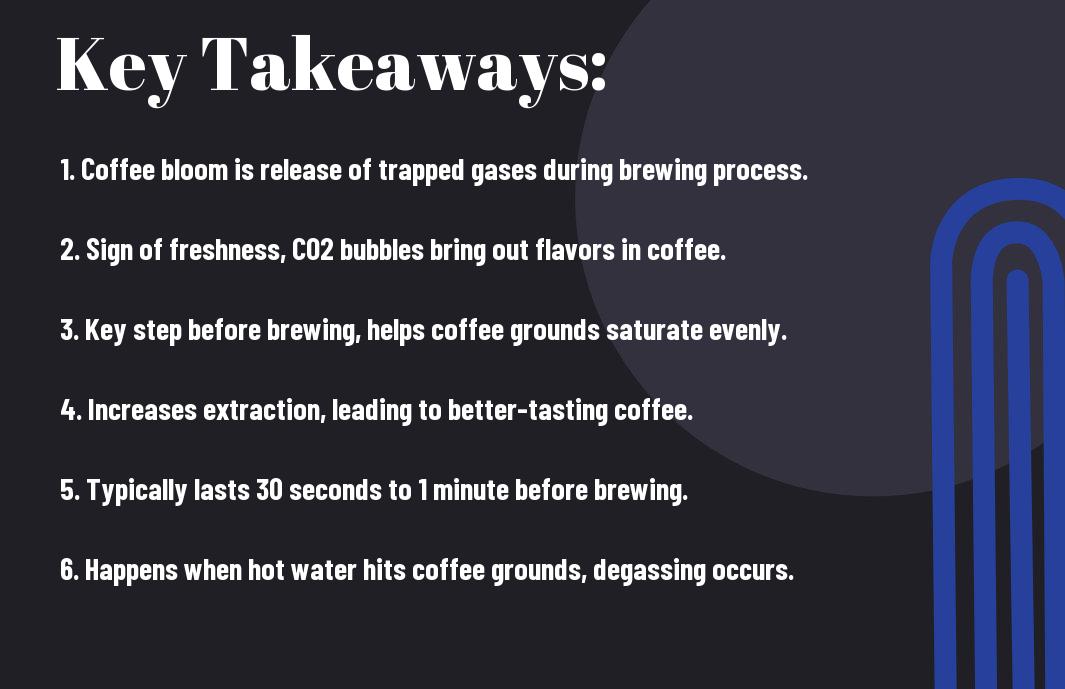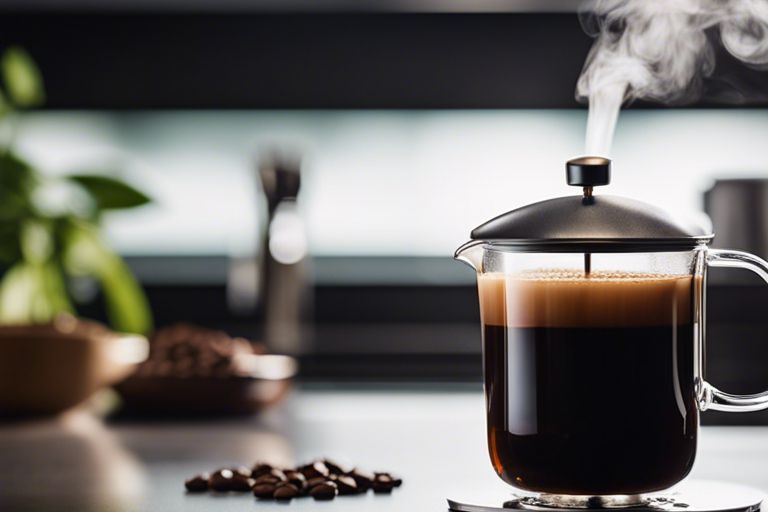There’s a unique component of your espresso that holds the key to its richness and flavor – the elusive coffee crema. This velvety layer of golden-brown froth crowning your shot isn’t just for aesthetics; it’s a telltale sign of a well-prepared espresso. Let’s probe into the world of coffee crema, unraveling its significance, how it forms, and why it’s prized by coffee aficionados worldwide.

Key Takeaways:
- Coffee Crema: It is the golden-brown foam that sits on top of an espresso shot, crafted during the brewing process.
- Sign of Quality: A rich crema indicates the freshness of the coffee beans and the effectiveness of the espresso machine.
- Texture and Flavor: The crema adds a velvety texture to the espresso and enhances the overall taste by balancing bitterness with a hint of sweetness.
- Crema Maintenance: Factors like bean quality, grind size, and machine pressure influence the crema’s thickness and longevity.
- Enjoyment: Sipping an espresso with a thick crema is a delight for coffee enthusiasts, offering a visual appeal and a burst of flavors with each sip.
Defining Coffee Crema
While enjoying your favorite espresso shot or cappuccino, you may have noticed a delightful layer of foam-like substance resting on top of your coffee – that’s the coffee crema. This golden-brown froth not only adds aesthetic appeal to your beverage but also contributes significantly to its flavor and aroma.
The Science Behind Crema Formation
On a chemical level, coffee crema is primarily composed of emulsified oils and carbon dioxide gas, a byproduct of the coffee bean roasting process. When high-pressure hot water passes through finely ground coffee in an espresso machine, these elements are forced to the surface, creating the distinctive crema layer.
The Role of Espresso Machines
The espresso machine plays a vital role in the formation of coffee crema. By subjecting the coffee grounds to 9 bars of pressure (or higher), espresso machines facilitate the emulsification of oils and extraction of carbon dioxide, resulting in the creamy layer we all love.
For instance, the type of espresso machine, the grind size of the coffee, and the brewing temperature all play a part in determining the quality and thickness of the crema atop your espresso. A well-maintained and correctly operated espresso machine is vital for achieving that perfect crema with every brew.

Characteristics of Coffee Crema
There’s an art to understanding the characteristics of coffee crema, the golden-brown layer that crowns a well-prepared espresso shot. This velvety foam is a symbol of quality and plays a vital role in the overall coffee-drinking experience.
Texture and Mouthfeel
Crema should be thick and velvety, with tiny bubbles dispersed evenly throughout the surface. When properly extracted, it should have a creamy texture that complements the intensity of the espresso beneath it. The mouthfeel of crema is rich and luxurious, adding a smooth layer to each sip of coffee.
Flavor Profile and Aroma
Crema contributes significantly to the flavor profile and aroma of the espresso. It should have a slightly sweet taste with hints of bitterness, creating a balanced and complex flavor profile. Additionally, the aroma of the crema should be inviting, with notes of roasted coffee beans and a subtle hint of caramel.
Plus, the crema also serves as a natural insulator, helping to retain the heat of the espresso below and preserving its flavors until the last sip.
 In your forthcoming blog post, the chapter “Types of Coffee Crema” will be an necessary part of educating your readers about the diverse characteristics of this coffee element. Let’s explore the different types of coffee crema with a structured approach.
In your forthcoming blog post, the chapter “Types of Coffee Crema” will be an necessary part of educating your readers about the diverse characteristics of this coffee element. Let’s explore the different types of coffee crema with a structured approach.
Thick and Velvety Crema
To understand the different types of coffee crema, it is crucial to distinguish the thick and velvety crema. This type of crema is dense and rich in texture, often signaling a well-extracted espresso shot. Its luxurious appearance adds a layer of complexity to the coffee, enhancing both the visual appeal and the overall flavor profile.
Thin and Watery Crema
With thin and watery crema, the visual presentation of the coffee changes significantly. This type of crema appears less substantial and lacks the characteristic richness of thicker crema varieties. It may indicate a less than ideal extraction process or aging coffee beans.
Watery crema can result from various factors, such as using old coffee beans, improper tamping techniques, or inconsistencies in the espresso machine’s pressure. When encountering thin and watery crema, it is necessary to evaluate the coffee-making process to ensure a more favorable outcome in future brews.
- Thick and Velvety Crema
- Thin and Watery Crema
- Balanced Crema
- Layered Crema
- Speckled Crema
This structured breakdown of the types of coffee crema will provide your readers with a comprehensive understanding of the various textures and appearances they may encounter in their coffee experiences. Keeping Hemingway’s concise style in mind, this organized approach will help convey complex information in a clear and engaging manner.
Factors Affecting Coffee Crema
Keep in mind that several factors can influence the quality and quantity of the crema on your coffee. Here are some crucial factors to consider:
- Coffee Bean Quality and Roast Level
- Espresso Machine Maintenance and Cleaning
- Barista Skills and Technique
Any of these factors can impact the crema’s thickness, color, and overall quality. For more insights into the world of coffee, you may want to explore What is the difference between Americano and Café Crème?
Coffee Bean Quality and Roast Level
Coffee bean quality and roast level play a significant role in the crema’s formation. Freshly roasted beans with a medium to dark roast profile tend to produce a rich and creamy crema. The beans’ freshness and the level of oils present in the beans can also affect the crema’s texture and thickness.
Espresso Machine Maintenance and Cleaning
Quality espresso machine maintenance and cleaning are necessary for a perfect crema. A clean machine free from any coffee residues or mineral deposits ensures proper pressure and water flow, leading to a thicker and more consistent crema. Regular descaling and backflushing are crucial to keep your espresso machine in top shape.
Roast your day with a frothy crema by taking good care of your espresso machine.
Barista Skills and Technique
On top of using quality beans and maintaining your espresso machine, barista skills and technique also influence the crema’s quality. The way the coffee is tamped, the water temperature, and the extraction time all play a crucial role in creating a perfect crema. Baristas with proper training and experience can manipulate these variables to achieve the desired crema consistency and flavor profile.
The art of crafting a perfect crema lies in the hands of a skilled barista.
The Importance of Coffee Crema
Once again, we investigate into the world of coffee crema to explore its significance in coffee connoisseurs. The crema, a golden-brown layer that sits atop your espresso, is more than just a visually appealing component – it plays a crucial role in enhancing your overall coffee experience.
Enhancing Flavor Experience
Enhancing the flavor experience, coffee crema provides a velvety texture that complements the rich, bold flavors of the espresso. Its presence indicates a well-extracted shot, where the oils from the coffee beans are emulsified to create a complex and aromatic taste profile. When sipping a crema-topped espresso, you can expect a harmonious balance of bitterness, sweetness, and acidity that lingers on your palate.
Visual Appeal and Presentation
To coffee aficionados and baristas alike, the visual appeal and presentation of a well-crafted crema are equally as important as its taste. The crema adds a layer of sophistication to your coffee cup, signaling quality and freshness. Its distinct hue and creamy texture serve as a visual cue for the richness and intensity of the espresso beneath it.
The coffee crema not only enhances the flavor profile of your espresso but also elevates the overall sensory experience of enjoying a cup of coffee. Its presence can indicate the quality of the beans, the skill of the barista, and the freshness of the brew. Next time you take a sip of your favorite espresso, take a moment to appreciate the golden layer of crema that tops it off.
Common Misconceptions About Coffee Crema
Debunking the Myth of Over-Extraction
Now, one common misconception about coffee crema is that its presence indicates over-extraction. This belief stems from the idea that the crema is a result of excessive pressure during the brewing process. However, crema is actually a natural byproduct of brewing espresso and is not necessarily linked to over-extraction.
Separating Fact from Fiction
For many coffee enthusiasts, there is a misconception that the crema is the primary indicator of the quality of an espresso shot. While crema can certainly enhance the visual appeal of a shot and contribute to its overall flavor profile, it is not the sole factor to consider. The taste, aroma, and mouthfeel of the espresso are equally important in determining its quality.
Myth from the reality, it is imperative to understand that while crema is a desirable component of a well-made espresso, its presence alone does not guarantee a perfect shot. The crema should complement the overall sensory experience of the coffee, adding a layer of texture and flavor without overshadowing the taste of the espresso itself.
Conclusively
Understanding the essence of a coffee crema is delving into the intricate world of coffee craftsmanship. This thin layer of golden goodness atop a freshly brewed espresso is a visual and sensory delight, showcasing the quality of the beans used and the barista’s skill. It not only adds a luxurious touch to a cup of coffee but also enhances the flavor and overall experience. So next time you take a sip of your favorite espresso, take a moment to appreciate the beauty and complexity of the crema that graces its surface.
FAQ
Q: What is a coffee crema?
A: Coffee crema is the golden-brown layer of foam that forms on the top of a freshly brewed espresso shot. It is a sign of a well-extracted espresso and adds to the overall flavor and aroma of the coffee.
Q: How is coffee crema formed?
A: Coffee crema is formed when hot water is forced through finely ground coffee beans under high pressure. The emulsification of oils in the coffee during the brewing process creates the creamy layer on top.
Q: What does coffee crema taste like?
A: Coffee crema has a rich and creamy texture with a slightly sweet taste. It enhances the overall coffee experience by providing a smooth and velvety mouthfeel.
Q: Does coffee crema affect the flavor of the coffee?
A: Yes, coffee crema plays a significant role in the flavor profile of espresso. It helps trap the aroma and volatile compounds in the coffee, resulting in a more flavorful and aromatic cup of coffee.
Q: Why is coffee crema important?
A: Coffee crema is important as it indicates the freshness of the coffee beans, the quality of the grind, and the proper extraction of the espresso shot. It also adds visual appeal to the coffee and enhances the overall drinking experience.
Q: How long does coffee crema last?
A: Coffee crema is a transient layer that begins to dissipate as soon as the espresso shot is brewed. It typically lasts for a few minutes before blending into the rest of the coffee.
Q: Can you make coffee crema at home?
A: Yes, you can create coffee crema at home by using a high-quality espresso machine that can generate the necessary pressure to emulsify the coffee oils and create the creamy layer on top of your espresso shot.









